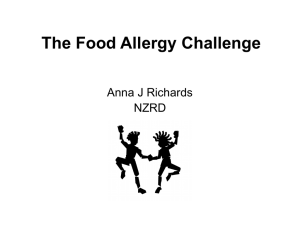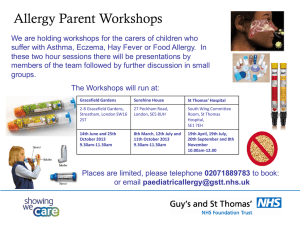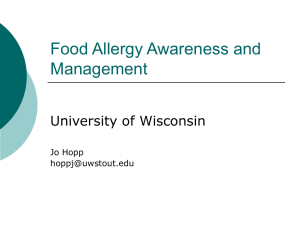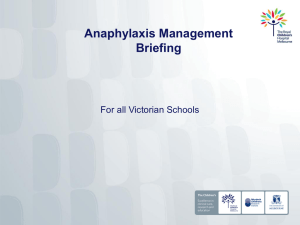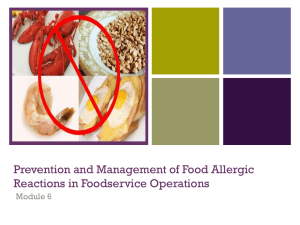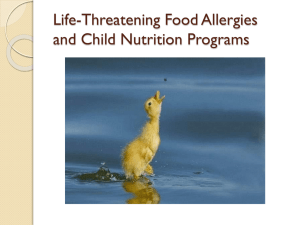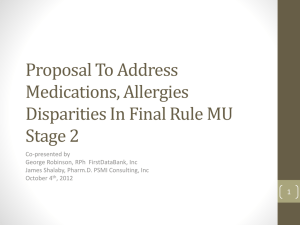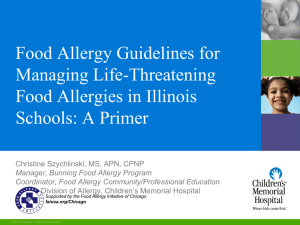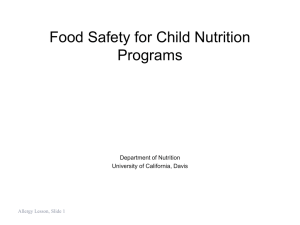Food-Allergy-PowerPoint-Presentation-2
advertisement
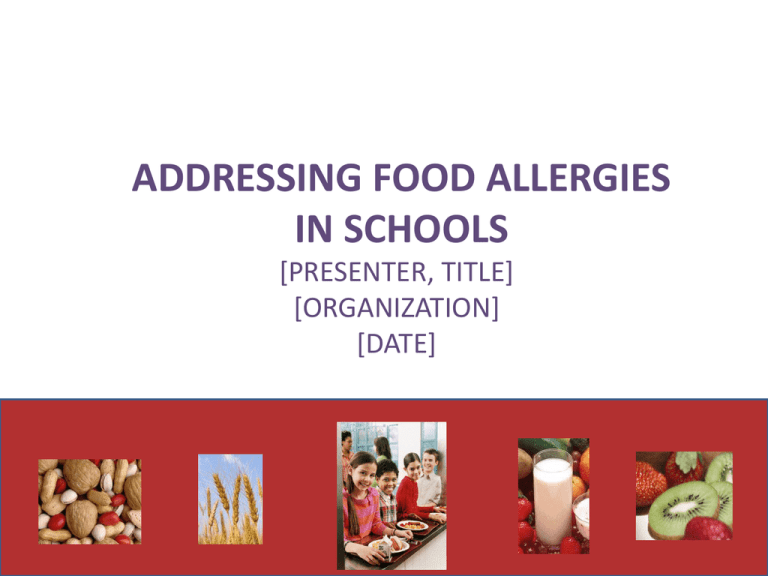
ADDRESSING FOOD ALLERGIES IN SCHOOLS [PRESENTER, TITLE] [ORGANIZATION] [DATE] 1 SESSION OBJECTIVES 1.Develop an awareness of food allergy basics 2.Learn why schools should address food allergies 3.Understand the components of food allergy policy 4.Learn about resources for policy and practice 2 Food allergy is a potentially serious immune response to eating or otherwise coming into contact with certain foods or food additives. A food allergy occurs when the immune system: 1) identifies a food protein as dangerous and creates antibodies against it; and 2) tries to protect the body against the danger by releasing substances, such as histamine, tryptase, and others, into our blood when that food is eaten. 3 FOOD ALLERGY VS. FOOD INTOLERANCE Food allergy is a potentially serious immune response to eating certain foods. Food Intolerance is an adverse reaction to food that does not involve the immune system and is not life-threatening. Example Lactose intolerance Trouble digesting milk sugar (lactose) Symptoms Might include abdominal cramps, bloating and diarrhea 4 SYMPTOMS Trouble swallowing Shortness of breath Repetitive coughing Voice change Nausea & vomiting Diarrhea Abdominal cramping One or more symptoms: Can occur within minutes up to hours Can be mild to life-threatening Swelling Hives Eczema Itchy red rash Drop in blood pressure Loss of consciousness 5 LIFE-THREATENING REACTION: ANAPHYLAXIS A serious allergic reaction that is rapid in onset and may cause death Food Insect Venom Medications Latex 6 TREATMENT OF ANAPHYLAXIS • Epinephrine by injection is the treatment for a serious reaction • Quick administration is key – a delay can be deadly • Follow-up care and observation in the emergency room for 4-6 hours • Biphasic reactions occur about 20% of the time (symptoms improve or disappear, then the 2nd wave can be worse than the first) 7 WHY SHOULD SCHOOLS BE PREPARED TO ADDRESS FOOD ALLERGIES? • Responsibility for health and safety of children at school • Food allergy is the most common cause of anaphylaxis. • Need for immediate response • Factor when dealing with other chronic conditions. • Unique social and emotional challenges 8 WHY IS COMPREHENSIVE FOOD ALLERGY POLICY NEEDED? • Increased presence of students with food allergy; 18% increase (children under 18) 1997 – 2007 • All students need to be safe and ready to learn – Teens are the highest risk group for fatal allergic reactions • Emergencies are inevitable – Proactive approach rather than reactive 9 LAWS AND LIABILITY • A life-threatening food allergy can be considered a disability under federal laws – Rehabilitation Act of 1973, Section 504 – The Individuals with Disabilities Education Act (IDEA) – The Americans with Disabilities Act (ADA), along with the ADA Amendments of 2008 (ADAA) • Assure compliance for privacy and confidentiality – Family Educational Rights and Privacy Act (FERPA) and – Health Insurance Portability and Accountability Act of 1996 (HIPAA) • Civil rights claim on behalf of student 10 – Follow the laws or parents/caregivers can file a claim MANAGING FOOD ALLERGIES Shared responsibility among schools, students, families, and healthcare providers Avoidance of food allergens Being prepared in case of a reaction 11 Healthcare Providers The Partnership Physicians, Nurses, Allied Health Professionals Communication / Education School Administrator Nurse Food Service Faculty Others Student’s Safety Families including students 12 AVOIDANCE OF KNOWN FOOD ALLERGENS Eight (8) foods cause ninety (90) percent of the food allergic reactions in the United States: Milk Eggs Wheat Soy Peanuts Tree Nuts Fish Shellfish 13 REVIEW What Questions Come to Mind? 14 Comprehensive Policy Guidance: Management of Life-Threatening Food Allergies in Schools 15 SAFE AT SCHOOL AND READY TO LEARN: 10 POLICY COMPONENTS 1. Identification of students with food allergies and provision of school health services 2. Individual written management plans 3. Medication protocols: storage, access, and administration 4. Healthy school environments: comprehensive and coordinated approach 5. Communication and confidentiality 6. Emergency response 7. Professional development and training for school personnel 8. Awareness education for students 9. Awareness education and resources for parents/caregivers 10. Monitoring and evaluation 16 IDENTIFICATION OF STUDENTS WITH FOOD ALLERGIES AND PROVISION OF SCHOOL HEALTH SERVICES • Identify students with food allergies • Provisions of appropriate school health services, including medication administration • Follow state and federal privacy and confidentiality laws 17 INDIVIDUAL WRITTEN MANAGEMENT PLANS • Individual Healthcare Plan (IHP or IHCP) • Emergency Care Plan (ECP) • Develop in collaboration with others 18 FOOD ALLERGY ACTION PLAN 19 MEDICATION PROTOCOLS: STORAGE, ACCESS, AND ADMINISTRATION • Allow for quick access • Protect the safety of students and the medications • Follow state laws for storage, access, and administration of medication 20 HEALTHY SCHOOL ENVIRONMENTS: COMPREHENSIVE AND COORDINATED APPROACH Create a plan to manage food allergy across the school system • Classrooms • Cafeteria • Buses • Field Trips • Before/after school programs • School sponsored events 21 COMMUNICATION AND CONFIDENTIALITY • Comply with state and federal privacy and confidentiality laws and accommodate parent requests, as feasible • Develop plans with the intent to inform all personnel involved in the care of a student and increase and enhance awareness of lifethreatening food allergies 22 EMERGENCY RESPONSE • Food allergy as part of an “all-hazards approach” • Written emergency procedures for dealing with a life-threatening food allergy reaction - Assure rapid accessibility to epinephrine to prevent a delayed response • Roles and responsibilities 23 PROFESSIONAL DEVELOPMENT AND TRAINING FOR SCHOOL PERSONNEL • Check for compliance with policies and procedures • Provide annual training: • • • District/school policies, procedures, and plans for managing students with chronic health conditions Basic information such as signs, symptoms, and risks associated with food allergy and anaphylaxis Strategies that reduce the risk of exposure to identified allergens throughout the school day 24 AWARENESS EDUCATION FOR STUDENTS • Educate all students on food allergy • Incorporate food allergy awareness as part of the district’s health education curriculum • Provide annual education: • • • Support for classmates with chronic health conditions, such as food allergy Knowledge of potential allergens and the signs, symptoms and potential of a life-threatening reaction Importance of following district health and wellness policies and relevant guidelines regarding hand washing, food-sharing, allergensafe zones, and student conduct. 25 A TOPIC NOT TO BE OVERLOOKED: BULLYING • Teasing or taunting for food allergy should never be allowed; bullying could come from students, teachers, staff, or parents • For staff: Bullying prevention, including responsibility to address any harassment, hazing (e.g., forced consumption of the known allergen), or bullying and enforce consequences • For students: Bullying prevention, including reporting any harassment, hazing or bullying to appropriate school personnel. • School’s response to reported bullying should be made clear at the outset, should be followed through, and should 26 be both therapeutic and punitive AWARENESS EDUCATION AND RESOURCES FOR PARENTS/CAREGIVERS • Provide awareness education and resources through use of qualified personnel. Increase understanding of special needs of students with food allergies. • In-person education is desirable, but written communications can also be effective 27 MONITORING AND EVALUATION • Creating food allergy policy is a process that can be modeled after CDC’s 6-Steps Framework • • • • • • • Assess needs and review data Engage stakeholders Educate, practice and communicate about policies and programs Focus the evaluation design Gather credible evidence and justify conclusions Implement needed changes and share lessons learned Review and update policy and practices after an incident of food allergic reaction and at least annually 28 MONITORING AND EVALUATION The guide’s policy component checklist: • Systematic approach to managing food allergies • Gauges areas that need attention and identifies specific actions for improvement • Tracks inclusion and implementation of each element 29 MONITORING AND EVALUATION Instructions for the policy component checklist: • Check “Included” or “Not Included” for whether or not each element is in the policy • If the element is included in the policy, check if the element has been “Implemented” or “Not Implemented” in practice • Use notes section to document specific actions for improvement Optimal: Each element is both “Included” and “Implemented” at the district and school levels30 FOOD ALLERGY POLICY COMPONENT CHECKLIST Sample Essential Component A: Identification of students with lifethreatening food allergy and provision of school health services Develop, implement, monitor, and update a school health services plan for students with food allergies in accordance with privacy/confidentiality laws. Elements Included Not Included Implemented Not Implemented Notes: Specify what is needed for this element to be included and/or implemented 1. Collect information on students with lifethreatening food allergies 2. Coordinate a process to acquire current student information from healthcare providers and parents 3. Document and keep current parental consent for medication administration 31 POLICY EXAMPLE The NSBA Food Allergy Policy Guide contains sample policies: • Liberty School District, Missouri • Waukee School District, Iowa • Connecticut Association of Boards of Education • State of Rhode Island Excerpt from Liberty School District, MO Allergy Management Policy Board Policy JHC Liberty Public Schools is committed to providing a safe and nurturing environment for students. The Liberty Board of Education understands the increasing prevalence of life threatening allergies among school populations. Recognizing that the risk of accidental exposure to allergens can be reduced in the school setting, Liberty Public Schools is Committed to working in cooperation with parents, students, and physicians, to minimize risks and provide a safe educational environment for all students. The focus of allergy management shall be on prevention, education, awareness, 32 communication and emergency response. REFERENCES • • • • • • • • • • • American Academy of Allergy, Asthma, and Immunology (AAAAI) Board of Directors. (1998). Anaphylaxis in schools and other child-care settings. Journal of Allergy and Clinical Immunology, 102, 173-176. Branum, A. M. & Lukacs, S. L. (2008). Food allergy among U.S. children: Trends in prevalence and hospitalizations. NCHS Data Brief (No. 10). Branum, A, M. & Lukacs, S.L. (2009). Food allergy among children in the United States. Pediatrics, 124, 1549-55. Bock, S.A., Muñoz-Furlong, A., & Sampson, H.A. (2007). Further fatalities due to anaphylactic reactions to food: 2001 to 2006. Journal of Allergy and Clinical Immunology, 119, 1016-1018. Centers for Disease Control and Prevention. (2009). Framework for program evaluation in public health. MMWR: Recommendations and Reports. 48, 1-40. Retrieved from http://www.cdc.gov/mmwr/preview/mmwrhtml/rr4811a1.htm Decker, W.W., Campbell, R.L., Manivannan, V., Luke, A., St Sauver, J.L., et al. (2008). The etiology and incidence of anaphylaxis in Rochester, Minnesota: A report from the Rochester Epidemiology Project. Journal of Allergy and Clinical Immunology, 122, 1161-1165. Food Allergy &Anaphylaxis Network (FAAN). (n.d.). Frequently asked questions. Retrieved from http://www.foodallergy.org/questions.html Lieberman, J.A., Weiss, C., Furlong, T.J., Sicherer, M., Sicherer , S.H. (2010). Bullying among pediatric patients with food allergy. Annals of Allergy, Asthma & Immunology, 105, 282-286. Massachusetts Department of Education. (2002). Managing life threatening food allergies in school. Retrieved from http://www.doe.mass.edu/cnp/allergy.pdf National Association of School Nurses (NASN). (2010). Position statement: Delegation. NASN. (2004). Position statement: Rescue medications in school. 33 REFERENCES • • • • • • • • • • New York State Department of Health, New York State Education Department, & New York Statewide School Health Services Center. (2008). Making the difference: Caring for students with life-threatening food allergies. One Hundred Eleventh Congress of the United States of America. (2010). H.R. 2751: FDA Food Safety Modernization Act. Retrieved from http://www.gpo.gov/fdsys/pkg/BILLS-111hr2751enr/pdf/BILLS111hr2751enr.pdf Rotrosen, D., & Fauci, A. (2008). Raising awareness of the personal and research challenges of food allergy. Retrieved from http://www3.niaid.nih.gov/news/newsreleases/2008/food_allergy08.htm Sheetz , A. H., Goldman, P. G., Millett, K., Franks, J. C., McIntyre, C. L., Carroll, C. R., et al., (2004). Guidelines for managing life-threatening food allergies in Massachusetts schools. Journal of School Health, 74, 155-160. Sicherer, S.H., Furlong, T.J., DeSimone, J., & Sampson, H.A. (2001). The U.S. peanut and tree nut allergy registry: Characteristics of reactions in schools and child care. Journal of Pediatrics, 138, 560-565. Sicherer, S.H., Mahr, T., & the Section on Allergy and Immunology. (2010). Management of food allergy in the school setting. Pediatrics, 126, 1232-1239. U.S. Department of Agriculture Food and Nutrition Service. (2001). Accommodating children with special dietary needs in the school nutrition programs. Guidance for school food service staff. Retrieved from http://www.fns.usda.gov/cnd/guidance/special_dietary_needs.pdf U.S. Department of Education. (2000). Office of Civil Rights memorandum regarding the prohibition of disability harassment. Retrieved from http://www.ed.gov/about/offices/list/ocr/docs/disabharassltr.html U.S. Department of Education. (2007). Free appropriate public education for students with disabilities: Requirements under Section 504 of the Rehabilitation Act of 1973. Retrieved from http://www.ed.gov/about/offices/list/ocr/docs/edlite-FAPE504.html Young, M.C., Muñoz-Furlong, A., Sicherer, S.H. (2009). Management of food allergies in schools: A perspective for allergists. Journal of Allergy and Clinical Immunology, 124, 175-182. 34 FOOD ALLERGY RESOURCES: www.nsba.org/schoolhealth National School Boards Association www.foodallergy.org www.nasn.org www.fns.usda.gov/cnd/guidance/special_dietary_needs.pdf www.cdc.gov/healthyyouth/ Division of Adolescent and School Health (DASH) 35 THANK YOU WHAT QUESTIONS DO YOU HAVE? For more information contact: National School Boards Association, School Health Programs 703-838-6722 SchoolHealth@nsba.org www.nsba.org/SchoolHealth 36

